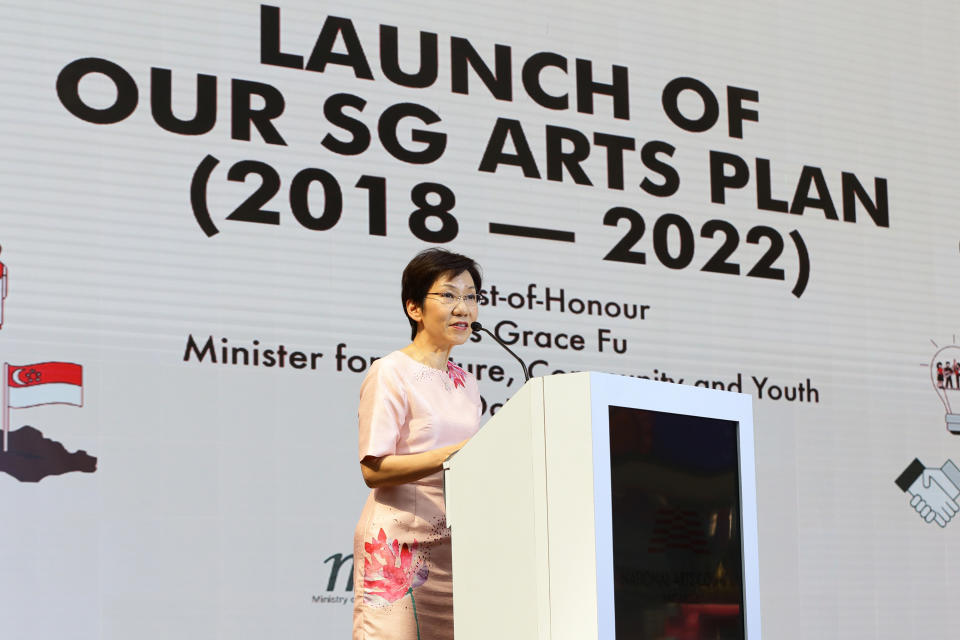Freelance arts professionals in Singapore to get support from new resource centre

A new resource centre for freelance arts professionals, as well as stronger collaborations with technology companies and academic institutions – these are among eight key priorities that the government has outlined in its new five-year arts plan.
The 116-page SG Arts Plan, which charts the new direction for arts in Singapore from 2018 to 2022, will also see more efforts in conducting in-depth arts research, growing audience locally and internationally as well as freeing up more public spaces for arts.
“The challenges we see today also present opportunities for our arts community: The emergence of the sharing and gig economy and the use of technology in both digital and analogue worlds,” said Guest-of-Honour and Minister for Culture, Community and Youth Grace Fu at the launch of the plan on Friday (19 October) at Our Tampines Hub.
The upcoming resource centre – both online and physical – will give art professionals access to shared services and information about various issues including legal issues, financial planning, and contract terms, said the National Arts Council (NAC).
Scheduled to launch in the first half of 2019, the centre will also aim to facilitate collaborations with potential partners to increase work opportunities for freelance arts professionals.
The NAC will also encourage employers in the arts sector to adopt the tripartite standard on contracting self-employed persons when engaging freelance workers.
Support for digital initiatives will allow the arts community to use technology as a tool to create, distribute and market the arts effectively.
This comprises funding, training opportunities, and networking sessions for both the arts and technology sectors, said the NAC, who said they will work with public agencies as well as cultural institutions on the digitalisation of local artworks.
“In Singapore, technology is relatively underutilised in arts and culture sector, lagging behind global leaders such as Australia and United Kingdom,” the NAC added.
To support the industry’s capability development needs, the NAC will facilitate collaboration between Institutes of Higher Learning (IHLs) and other training providers to plan career pathways in areas such as arts education and arts programming.
Cultivating greater interest in arts among Singaporeans
There were nearly 6,000 non-ticketed performing arts activities in 2016, with a five-year record attendance of over 9.2 million people at these activities and over 5.1 million in visitorship figures to museums and heritage institutions, according to the Singapore Cultural Statistics 2017.
Ticketed attendance for performing arts events, however, has declined in the past five years, from 2.06 million in 2012 to 1.81 million in 2016, although overall arts attendance levels, including free events, continued to rise.
NAC’s assistant chief executive for sector development (arts) Low Eng Teong, said, “Free events are a low barrier to get more people to be interested in the arts. Our next step is to see how that level of engagement when someone attends a free event can go deeper and eventually support arts by purchasing tickets.”
Cultivating ticket-paying audiences, however, requires extensive research on their consumption patterns and behaviours, added NAC’s assistant chief executive of planning and engagement Kenneth Kwok.
Notably, only 37 per cent of Singaporeans said they were interested in the arts, 74 per cent agreed that the arts and culture improved the quality of life for everyone, according to the 2017 Population Survey on the Arts.
Kwok said, “We have a growing number of Singapore artists who are passionate about bringing their arts to such communities of spaces and needs. We want to work together with researchers and academic institutions to do deep research in partnership with the art community to show how arts can make a powerful difference in the social sector.”
The NA said Singapore can strive to be a cultural focal point in Southeast Asia through partnerships with international festivals, presenters, other arts councils and institutions.
The five-year blueprint was developed in consultation with more than 700 people from the arts community, stakeholders and the general public, across over 40 engagement sessions held from February to September.
The plan, built on the 2012’s Arts and Culture Strategic Review, will be reviewed every five years.
More Singapore stories:
Strong public views on social enterprise hawker centres will lead to change: Makansutra’s K F Seetoh

